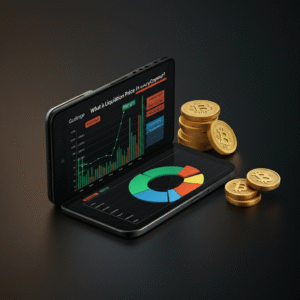Bitcoin has once again captured global attention as it trades near $110,000 in early November 2025, marking one of its strongest performances since the 2021 bull run.
This renewed momentum comes amid shifting market conditions — from central bank policy changes to rising institutional interest — making Bitcoin a key topic for both retail and professional investors.
Current Bitcoin Market Snapshot (Early November 2025)
Bitcoin’s price hovering around $110,000 reflects a mix of optimism and caution. The crypto market has seen:
-
Strong inflows from institutional investors.
-
Increased ETF trading volumes in the U.S. and Europe.
-
Moderate correction after touching $118,000 in late October.
-
Growing speculation ahead of the next Fed policy decision and Bitcoin’s halving effects stabilizing.
Overall sentiment remains bullish but watchful, as traders assess whether this momentum can sustain through the year’s end.
Why the $150,000 Question Matters
The possibility of Bitcoin hitting $150,000 by the end of 2025 isn’t just about numbers — it’s a reflection of broader market psychology and confidence. For investors:
-
It could validate crypto as a mainstream asset class.
-
Institutional funds might expand BTC exposure, influencing altcoin markets too.
-
Retail investors see it as a signal of the next mega bull cycle.
For traders, the $150K mark represents a psychological resistance — a point that could trigger high volatility, large liquidations, and rapid sentiment shifts between greed and caution.
Current Bitcoin Performance
Latest Price Movement and Market Volatility in Q4 2025
Bitcoin is currently trading near $110,000 in early November 2025 after reaching almost $118,000 in late October. The market has now entered a consolidation phase, fluctuating between $105,000 and $116,000 as traders await new catalysts like the Federal Reserve’s next rate move and broader market liquidity changes.
Volatility remains noticeable, with sharp intraday swings driven by futures liquidations and leveraged trades. However, overall sentiment stays optimistic, as institutional demand continues to absorb selling pressure.
Institutional Inflows Through ETFs and Spot Markets
Institutional investment has become a defining force behind Bitcoin’s 2025 rally. Spot Bitcoin ETFs have witnessed billions of dollars in inflows across Q3 and early Q4, reinforcing long-term investor confidence.
Large financial institutions, including asset managers and hedge funds, are now accumulating Bitcoin through ETFs and direct spot purchases, signaling strong market participation. These inflows have also improved liquidity and price stability, keeping Bitcoin’s momentum alive despite short-term volatility.
Whale Accumulation and On-Chain Activity Trends
On-chain data shows that long-term holders and mid-sized investors are steadily accumulating Bitcoin, expecting higher prices in the coming months. Nearly 97% of circulating BTC remains in profit, showing strong network fundamentals.
Exchange reserves continue to drop, meaning fewer coins are available for selling — a bullish sign of supply tightening. Meanwhile, whales (wallets holding 1,000 BTC or more) are showing mixed behavior: some are taking partial profits at highs, while others are adding during dips. The overall trend still points toward net accumulation, supporting Bitcoin’s strong price base for late 2025.
Supply Dynamics and Halving Effect
Impact of the 2024 Bitcoin Halving on Circulation and Miner Behavior
The 2024 Bitcoin halving cut miner rewards from 6.25 BTC to 3.125 BTC per block, meaning new coins are entering the market at half the previous rate. This has reduced daily Bitcoin production, making the asset more scarce.
After the halving, many miners upgraded to more efficient machines or joined large mining pools to keep profits stable. The overall mining competition stayed strong, showing that most miners believe in Bitcoin’s future value despite lower rewards.
Reduction in Available Supply and Long-Term Scarcity Effects
Because fewer new Bitcoins are created every day, market supply is getting tighter. Combined with strong ETF demand and long-term holders not selling, this creates a supply squeeze — fewer coins available for buyers.
Historically, every halving has started a new bull cycle within a year, as limited supply meets growing demand. The same pattern seems to be forming in 2025, with prices rising as supply scarcity increases.
Miner Profitability and Its Influence on Selling Pressure
Miner income now depends more on transaction fees and Bitcoin’s price growth. When prices stay high (like above $100,000), miners can still make good profits and hold their coins instead of selling.
If prices fall or energy costs rise, some miners may sell part of their holdings to cover expenses — but at the current price range, selling pressure remains low to moderate. This supports the market’s long-term stability and keeps upward momentum strong.
Demand Drivers That Could Push Bitcoin to $150,000
Continued ETF Inflows and Rising Institutional Adoption
One of the biggest reasons Bitcoin could reach $150,000 by the end of 2025 is the ongoing inflow of money into Bitcoin ETFs. These funds make it easier for large institutions — like banks, pension funds, and investment firms — to buy Bitcoin safely.
As ETF demand rises, more coins are locked up in institutional custody, reducing market supply and pushing prices higher. Many experts believe that continued institutional adoption could drive the next major leg of the bull run.
Central Banks’ Monetary Policies and Inflation Hedging Behavior
Central banks around the world are still dealing with high inflation and uncertain interest rate policies. If the U.S. Federal Reserve or European Central Bank keeps rates lower or restarts money printing, investors will likely turn to Bitcoin as an inflation hedge.
Bitcoin’s limited supply makes it attractive when traditional currencies lose value, which can increase demand from both institutional and retail investors looking for long-term protection.
Growth of Retail Participation and Global Payment Integration
Retail participation — meaning small and medium investors — has also started to grow again in 2025. More people are using Bitcoin not just for investment but also for payments and savings, especially through apps and wallets linked to global payment systems.
Countries in Latin America, Africa, and Asia are seeing fast adoption because Bitcoin gives people an alternative to unstable local currencies. This growing user base adds real-world demand and helps support higher prices.
Technological Innovation and Increasing Adoption in Developing Economies
New technologies such as Bitcoin’s Lightning Network and Layer-2 solutions have made transactions faster and cheaper, encouraging everyday use.
Developing economies are now adopting Bitcoin for cross-border trade, remittances, and e-commerce — reducing dependency on traditional banks.
As more businesses and governments explore crypto-friendly regulations, Bitcoin’s utility and global trust continue to expand, setting the stage for a potential rise toward $150,000 in the coming months.
Regulatory and Economic Risks
Ongoing Government Regulation in Major Economies
Regulation remains one of the biggest uncertainties for Bitcoin’s growth. Major economies like the U.S., U.K., and European Union are still defining rules for crypto exchanges, stablecoins, and decentralized finance platforms.
While some laws aim to protect investors, too much regulation or unclear policies can slow institutional adoption. If governments increase compliance costs or limit access to crypto services, it could temporarily reduce trading activity and investor confidence.
Possible Restrictions on Crypto Trading and Taxation Policies
Several countries are tightening their stance on crypto trading and taxation. Higher capital gains taxes, reporting requirements, or restrictions on anonymous wallets can discourage retail traders.
If major markets decide to enforce strict limits on cross-border transfers or on-ramp/off-ramp systems, it might reduce liquidity and make it harder for new investors to enter. However, moderate and transparent taxation could help legitimize the industry in the long run.
Macroeconomic Headwinds Such as High Interest Rates or a Strong U.S. Dollar
Bitcoin’s performance is also tied to global economic conditions. When central banks keep interest rates high, investors often prefer traditional assets like bonds over riskier options like crypto.
A strong U.S. dollar can also put pressure on Bitcoin prices because it makes alternative assets less attractive for international buyers.
If inflation falls faster than expected or global growth slows, it could lead to lower demand for Bitcoin as a hedge, temporarily limiting its upside potential.
Technical and Market Structure Factors
Key Resistance and Breakout Zones to Monitor ($120K, $135K, $150K)
Bitcoin is currently trading near $110,000, with the next key resistance levels at $120,000, $135,000, and finally $150,000 — the major psychological and technical barrier.
If Bitcoin breaks above $120K with strong volume, it could trigger a new wave of buying from both retail and institutional traders. The $135K zone may act as a mid-term resistance, where short-term profit-taking could occur before another push higher.
A clear breakout above $150K would likely confirm a full-scale bull cycle continuation, opening potential targets near $180K–$200K based on Fibonacci and long-term trend models.
Market Liquidity, Leverage Data, and Exchange Activity
Liquidity levels have improved significantly in late 2025 due to the growing presence of ETFs and institutional traders. This helps reduce price manipulation and makes large trades smoother.
However, futures market leverage remains high, which means sudden corrections can still happen if funding rates spike or liquidations cascade.
Exchange activity shows that spot trading volumes are stable, while derivatives volumes are rising — a sign that traders are actively positioning for a breakout but also increasing short-term volatility risk.
How Bitcoin’s Price Patterns Compare with Past Bull Cycles
When compared with past cycles (2017, 2021), the current 2025 rally shows a more mature and structured growth pattern. Price surges are now supported by institutional inflows, not just retail hype.
Previous bull runs saw extreme volatility and deep crashes; this time, pullbacks are shorter and supported by strong buying interest.
If the historical post-halving trend continues, Bitcoin could still be in the mid-stage of its bull cycle, suggesting room for further upside before reaching its final peak — possibly around or above $150,000 in late 2025.
Scenario Analysis for 2025
Bullish Case: Bitcoin surpasses $150,000 with strong momentum
In this scenario, Bitcoin breaks all past records and goes above $150,000. This can happen if ETF inflows stay strong, institutional investors keep buying, and inflation remains high. The 2024 halving reduces supply, while positive sentiment and adoption boost the rally.
Base Case: Bitcoin consolidates between $120K–$140K
Here, Bitcoin trades mostly between $120,000 and $140,000. The market stays healthy with balanced buying and profit-taking. Economic conditions remain stable, and no major policy changes occur. Investors hold positions while waiting for the next move.
Bearish Case: Bitcoin retraces below $100K due to macro or policy shocks
In this case, Bitcoin drops below $100,000 due to tight regulations, interest rate hikes, or a stronger U.S. dollar. Miner selling and reduced liquidity may also trigger corrections. This scenario reflects fear-driven sentiment and lower institutional demand.
Key Events and Triggers to Watch
ETF inflow reports and institutional buying trends
One of the most important things to watch in the coming months is how much money continues to flow into Bitcoin ETFs. When big financial institutions and funds keep adding Bitcoin to their portfolios, it shows strong confidence in the market. These inflows not only support the price but also make Bitcoin more stable and trusted among traditional investors. If ETF demand stays high, it could push Bitcoin closer to the $150,000 mark.
Global interest rate decisions and inflation data
Another key factor is what central banks, especially the U.S. Federal Reserve, decide about interest rates. If rates go down, investors may move their money from bonds or savings into riskier assets like Bitcoin. On the other hand, if inflation stays high or grows, people often turn to Bitcoin as a store of value or inflation hedge. This connection between inflation, interest rates, and crypto demand will remain a major driver for Bitcoin’s price direction.
Large on-chain transfers, whale accumulation, or sell-offs
Bitcoin’s on-chain data gives a deep look into what big players — also called whales — are doing. If these whales are buying and holding, it usually means confidence in future growth. But if large amounts of Bitcoin start moving to exchanges, it could signal potential sell-offs and price drops. Tracking these wallet movements helps traders understand market mood and prepare for possible volatility.
Investor Strategy Insights
How to manage risk in a volatile environment
Bitcoin’s price can move sharply in both directions, so managing risk is essential. Investors should avoid using too much leverage and only invest what they can afford to lose. Setting stop-loss orders, taking profits at intervals, and keeping some cash aside for market dips can help balance risk. It’s also smart to stay updated with global news and market trends since major events can shift Bitcoin’s price quickly.
Long-term vs short-term investment planning
For long-term investors, the best approach is holding through volatility — trusting that Bitcoin’s limited supply and global adoption will drive value over time. For short-term traders, it’s better to focus on price trends, technical levels, and market momentum. Long-term holders should avoid reacting emotionally to small price drops, while traders must stay disciplined and stick to their strategies.
Portfolio diversification and safe exposure levels
Even though Bitcoin is promising, it shouldn’t be the only asset in your portfolio. A balanced strategy includes other assets like stocks, gold, and stablecoins. This way, if Bitcoin faces a sudden correction, other assets can reduce overall losses. Experts usually suggest keeping 5–15% of your total portfolio in Bitcoin, depending on your risk tolerance and financial goals.
Expert Forecasts and Market Models
Current analyst predictions for late 2025 and 2026
Most crypto analysts and financial experts believe Bitcoin could stay strongly bullish through late 2025 and into 2026. Several forecasts suggest that if institutional inflows remain steady and global inflation stays elevated, Bitcoin could move between $140,000 and $160,000 by the end of 2025. Some optimistic projections even see it touching $180,000 in early 2026, depending on how global liquidity and demand evolve.
However, more cautious experts warn that after such a strong rally, Bitcoin might enter a correction phase next year — similar to past cycles after major bull runs.
Models based on halving cycles and ETF demand projections
Bitcoin’s price models often revolve around its four-year halving cycle, where block rewards for miners are cut in half. Historically, prices tend to rise for 12–18 months after a halving, as supply tightens and demand increases. The 2024 halving has already reduced new Bitcoin supply, and combined with ETF-driven demand, it creates a strong bullish setup.
If ETF investments continue to grow at their current pace, models project Bitcoin could follow a similar pattern to the 2020–2021 rally, potentially reaching $150,000–$200,000 before stabilizing. Still, market timing and global macro conditions will play a big role in how far this next phase goes.
Conclusion
Final outlook for Bitcoin’s potential to reach $150,000
As of early November 2025, Bitcoin is trading near $110,000, showing strong resilience despite global uncertainty. With continued institutional demand, ETF inflows, and the long-term effects of the 2024 halving, Bitcoin has a realistic chance of reaching $150,000 before the end of 2025. However, this will depend on whether macroeconomic conditions — such as interest rate cuts or stable inflation — continue to support risk assets.
What could trigger the next breakout or correction phase
A breakout above $120,000–$125,000 could open the door for a sharp rally toward new highs, especially if ETF inflows rise and whale accumulation continues. On the flip side, major regulatory actions, profit-taking by institutions, or a strong U.S. dollar could cause Bitcoin to correct below $100,000.
In short, Bitcoin’s path to $150,000 looks promising, but the journey will likely include periods of volatility, making timing, discipline, and risk management key for investors in the months ahead.







